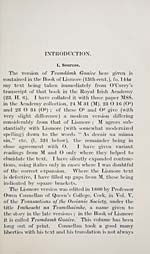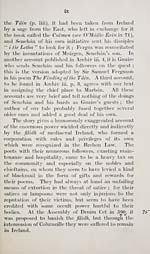Download files
Complete book:
Individual page:
Thumbnail gallery: Grid view | List view

reliable. He added some interesting (though not
always strictly relevant) notes.
A modern Irish rendering by the late Canon
O'Leary was published by the Irish Book Company
in 1915 under the title Guaire.
II. The Story.
The word fromdámh has been rendered by Professor
Thurneysen (Irische Heldensaga 254) " schzoere Schar
(der lastigen Gdste)," i.e., a heavy (burdensome or
troublesome) troop (of guests), Dám{h), a company,
party, is commonly used of a company of guests or
persons seeking entertainment, and very often of the
Jilidh. In a highly artificial and somewhat obscure
poem attributed to Flann Mainistrech ( + 1056) in LL
276 54, the names of the munter na Tromdáma are
enumerated, but only three of them (Grucc, Grace
and Grangait) occur in our text and there is nothing
to prove that the Tromdámh spoken of is that of
our tale, though very likely our author knew the
poem. Flann 's description of the Tromdámh is highly
uncomplimentary ; he terms them munter mallachta,
'■ accursed folk."
The present story relates how Senehán Torpéist,
chief ollave of Ireland some time in the 7th century,
set out with his followers, the Tromdámh, in quest
of the epic or narrative of the Tain Bo Cualnge
which had been lost, and how finally it was taken
down from the lips of Fergus mac Róich, one of the
chief participators in the Tain, who was temporarily
resuscitated for the purpose through the intercession
of the saints of Ireland. There are different accounts
of the recovery of the Tain in Irish literature.
According to one preserved in LL 2456 and printed
bv Windisch in the Introduction to his edition of
always strictly relevant) notes.
A modern Irish rendering by the late Canon
O'Leary was published by the Irish Book Company
in 1915 under the title Guaire.
II. The Story.
The word fromdámh has been rendered by Professor
Thurneysen (Irische Heldensaga 254) " schzoere Schar
(der lastigen Gdste)," i.e., a heavy (burdensome or
troublesome) troop (of guests), Dám{h), a company,
party, is commonly used of a company of guests or
persons seeking entertainment, and very often of the
Jilidh. In a highly artificial and somewhat obscure
poem attributed to Flann Mainistrech ( + 1056) in LL
276 54, the names of the munter na Tromdáma are
enumerated, but only three of them (Grucc, Grace
and Grangait) occur in our text and there is nothing
to prove that the Tromdámh spoken of is that of
our tale, though very likely our author knew the
poem. Flann 's description of the Tromdámh is highly
uncomplimentary ; he terms them munter mallachta,
'■ accursed folk."
The present story relates how Senehán Torpéist,
chief ollave of Ireland some time in the 7th century,
set out with his followers, the Tromdámh, in quest
of the epic or narrative of the Tain Bo Cualnge
which had been lost, and how finally it was taken
down from the lips of Fergus mac Róich, one of the
chief participators in the Tain, who was temporarily
resuscitated for the purpose through the intercession
of the saints of Ireland. There are different accounts
of the recovery of the Tain in Irish literature.
According to one preserved in LL 2456 and printed
bv Windisch in the Introduction to his edition of
Set display mode to: Large image | Transcription
Images and transcriptions on this page, including medium image downloads, may be used under the Creative Commons Attribution 4.0 International Licence unless otherwise stated. ![]()
| Early Gaelic Book Collections > Matheson Collection > Tromdámh Guaire > (12) |
|---|
| Permanent URL | https://digital.nls.uk/82339128 |
|---|
| Description | Items from a collection of 170 volumes relating to Gaelic matters. Mainly philological works in the Celtic and some non-Celtic languages. Some books extensively annotated by Angus Matheson, the first Professor of Celtic at Glasgow University. |
|---|
| Description | Selected items from five 'Special and Named Printed Collections'. Includes books in Gaelic and other Celtic languages, works about the Gaels, their languages, literature, culture and history. |
|---|

